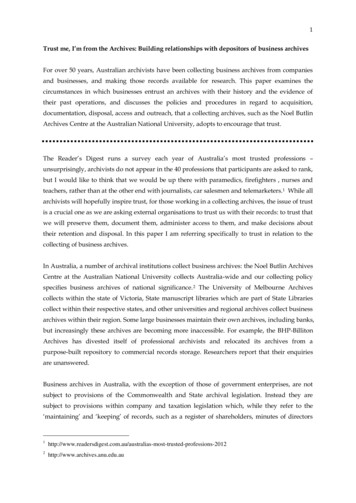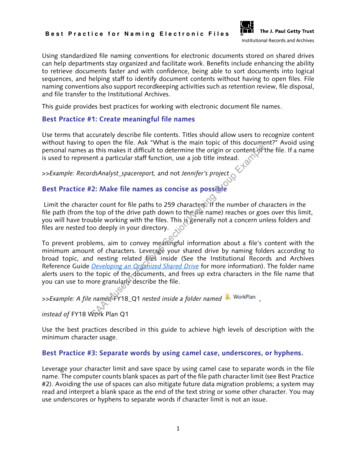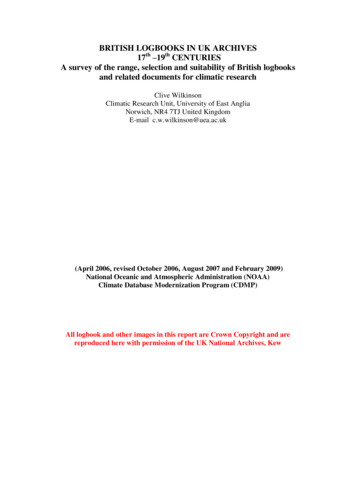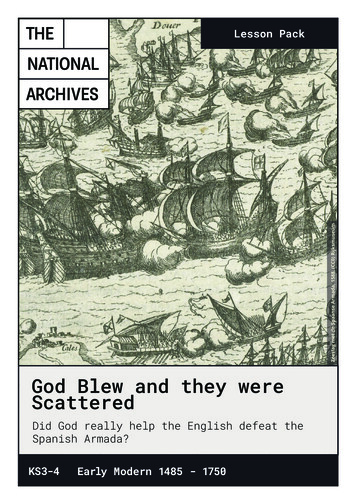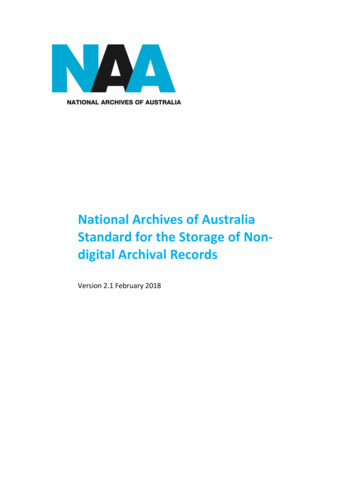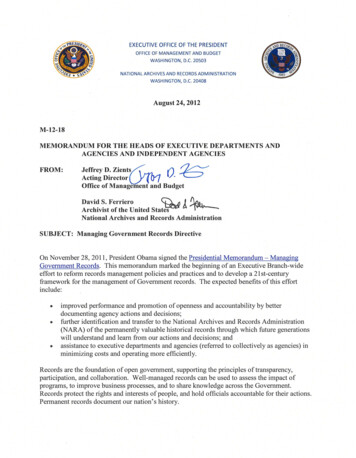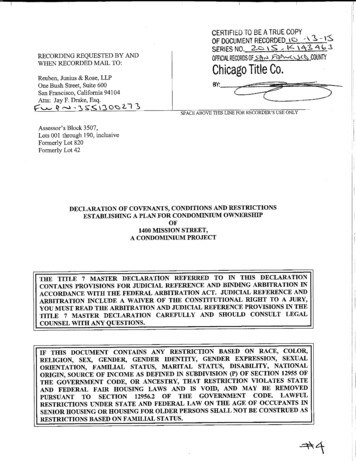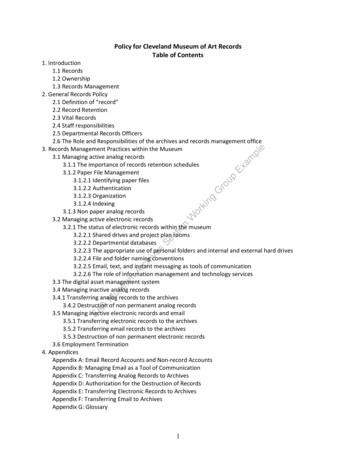
Transcription
Policy for Cleveland Museum of Art RecordsTable of e1. Introduction1.1 Records1.2 Ownership1.3 Records Management2. General Records Policy2.1 Definition of “record”2.2 Record Retention2.3 Vital Records2.4 Staff responsibilities2.5 Departmental Records Officers2.6 The Role and Responsibilities of the archives and records management office3. Records Management Practices within the Museum3.1 Managing active analog records3.1.1 The importance of records retention schedules3.1.2 Paper File Management3.1.2.1 Identifying paper files3.1.2.2 Authentication3.1.2.3 Organization3.1.2.4 Indexing3.1.3 Non paper analog records3.2 Managing active electronic records3.2.1 The status of electronic records within the museum3.2.2.1 Shared drives and project plan rooms3.2.2.2 Departmental databases3.2.2.3 The appropriate use of personal folders and internal and external hard drives3.2.2.4 File and folder naming conventions3.2.2.5 Email, text, and instant messaging as tools of communication3.2.2.6 The role of information management and technology services3.3 The digital asset management system3.4 Managing inactive analog records3.4.1 Transferring analog records to the archives3.4.2 Destruction of non permanent analog records3.5 Managing inactive electronic records and email3.5.1 Transferring electronic records to the archives3.5.2 Transferring email records to the archives3.5.3 Destruction of non permanent electronic records3.6 Employment Termination4. AppendicesAppendix A: Email Record Accounts and Non-record AccountsAppendix B: Managing Email as a Tool of CommunicationAppendix C: Transferring Analog Records to ArchivesAppendix D: Authorization for the Destruction of RecordsAppendix E: Transferring Electronic Records to ArchivesAppendix F: Transferring Email to ArchivesAppendix G: Glossary1
POLICY FOR CLEVELAND MUSEUM OF ART RECORDS1. IntroductionroupExample1.1 RecordsEvery year the Cleveland Museum of Art generates a large amount of recordedinformation. Much of this recorded information constitutes records as defined by thispolicy. Museum records are critical to the operation of the institution. Records protect themuseum’s legal rights and its ownership of property, ensure compliance with governmentand business regulations, and provide the means for keeping its constituency informed ofits activities, operations, and accomplishments. They document the care, security,ownership, and changing conditions of the collection. Records also provide the knowledgeof the institution’s history that is essential for internal communication and decision making.They are also the primary materials for historical and other essential research. The goal ofthis policy for museum records is to ensure that the museum’s documentary heritage ispreserved and appropriately maintained.SectionWorkingG1.2 OwnershipAll records created by Cleveland Museum of Art employees during the performance oftheir jobs are the property of the museum. Records must be managed by staff from thepoint of creation and may not be discarded, deleted, or removed from the museum exceptin accordance with formal procedures as outlined in this policy.SAAMuseumArchives1.3 Records ManagementThe museum utilizes records management principles to effectively control records. TheISO 15489 standard defines records management as “the field of management responsiblefor the efficient and systematic control of the creation, receipt, maintenance, use anddisposition of records, including the processes for capturing and maintaining evidence ofand information about business activities and transactions in the form of records”. Thepractice of records management includes the following activities: creating, approving, andenforcing records policies; developing and maintaining a records storage plan; identifyingand classifying records; managing access to records; and executing retention policies.2. General Records Policy2.1 Definition of “record”Information is recorded in many different types of formats including but not limited topaper, email, electronic document software, spreadsheets, web pages, databases,analog and digital audio files, analog and digital video files, photographs, and ephemera.Not all recorded information constitutes a record. The ISO defines a record as“information created, received, and maintained as evidence and information by anorganization or person in pursuance of legal obligations or in the transaction ofbusiness”. A record has value as evidence of institutional activity.2
ple2.2 Record RetentionThe museum retains records for varying lengths of time which is determined by anumber of factors including fiscal and legal requirements, and historical value. Thelength of time records are to be retained is codified in records retention schedules foreach department which lists types of records and how long they are to be kept. Recordsretention schedules list types of records by series. A record series is a set of recordsgrouped together because they relate to a particular subject or function, or result fromthe same activity. All records fall within series. Related records are efficiently managedas a group. Departmental schedules include both series that may be common to mayoffices and series that are unique to each office. The vital schedule lists the museum’smost important records, and those that must be recovered following a disaster. Recordsschedules are posted on the Ingalls Library web site. Access is password protected.hivesSectionWorkingGroupExam2.3 Vital RecordsA vital record is recorded information, regardless of format, that must be protected inthe event of an emergency or disaster because of sever consequences to the museum ifthe record is lost or destroyed. These are the records that document the museum’smost important legal, administrative, and fiscal decisions and policies. Most are highlyconfidential and must be afforded the highest security. Vital records are records thatwill be needed in anywhere from a few minutes to twenty-four hours after a disaster.They are records that, if lost or destroyed, would be both costly and time consuming torecreate. They can be active (currently in use in museum offices) or inactive (in archivesstorage). For these reasons vital records are listed on a separate records retentionschedule.SAAMuseumArcProtection of vital records is the responsibility of all museum employees. Protection ofvital records allows the museum to minimize disruption after an emergency, minimizeany economic impact of a disruption, provide for rapid restoration of services, andcomply with legal requirements. The primary protection method for vital records isthrough duplication and dispersal. Vital records that are produced in multiple orelectronic copies (e.g. audit reports, board minutes, budgets) should be sent to archivesimmediately upon publication with signed, finalized originals sent to archives accordingto the records schedule. If a vital record is in electronic format the hardware or softwareused to create the records also needs to be protected. Further information on disasterrecovery can be found in the museum’s disaster recovery plan.2.4 Staff responsibilitiesIf in the performance of your job you create records as documented on record retentionschedules, you have a responsibility to maintain those records from the point ofcreation in a secure and manageable environment. You also have an obligation todispose of records in an appropriate manner, whether that be by sending them toarchives, deleting them from museum servers, shredding, or other means of disposal. Itis critical to remember that all records created by Cleveland Museum of Art employeesduring the performance of their jobs are the property of the museum, must be managed3
from the point of creation, and may not be discarded, deleted, or removed from themuseum except in accordance with formal procedures as outlined in this policy.2.5 Departmental Records OfficersTo facilitate the management of records in museum offices a records officer isdesignated for each department. The records officer serves as the liaison betweenmuseum staff and the records management office. The duties of this position includeassisting staff with paper and electronic file management with particular attention tovital records, coordinating the timely transfer of records to the archives, facilitating thedisposition of records in offices that are at the end of their life cycle, and reviewingdepartmental records schedules for necessary updates and changes.WorkingGroupExample2.6 The Role and Responsibilities of the archives and records management officeThe archives department manages two separate but integrated functions. Records ofpermanent historical value are housed on site in secure collection storage and in an offline electronic server. Records transferred to the museum archives become theproperty of the archives. The archive staff process permanent records according toarchival standards and make them available to staff and patrons conducting museumresearch depending on the level of confidentiality of the records.MuseumArchivesSectionThe archive also serves as the records management office for the museum. Themuseum archivist is also the museum records manager. In this capacity the archivist isresponsible for creating and enforcing records policies; appraising both active andinactive records; conducting departmental records surveys in order to identify existingand newly created records; researching, writing, and updating records retentionschedules; providing for and managing off site storage of non permanent records;providing access to records in archives custody; and properly disposing of records thathave reached the end of their life cycle.A3. Records Management Practices Within the MuseumSA3.1 Managing active analog recordsAn analog record is one that is not digital (electronic). Analog records can be in a widevariety of formats such as paper documents, photographs, slides, audio tapes, videotapes, vinyl banners, T- shirts, buttons, ribbons, plaster casts, and limestone samples (allof which reside in the museum archives).3.1.1 The importance of records retention schedulesRecorded information must be identified as a record in order to be managedproperly. Once identified records are listed in retention schedules that detail howlong they are to be kept. It is critical that museum staff who create records befamiliar with the vitals record schedule and their departmental record schedule.Records schedules look like this:4
THE CLEVELAND MUSEUM OF ARTRECORDS RETENTION AND DISPOSITION SCHEDULEItem #Record Title (othertitles)DescriptionRetain inOfficeRetain inArchivesTotalComments1.CY calendar yearA active (project is ongoing)P permanent*P permanent, retain in office of tem #: Records are listed numerically from one to however many arenecessary for each department.Record Title: This is the common name by which a record series isknown. If record series are known by any other titles or nicknamesthis is included in the record title.Description: If the record series title is not self explanatory or needsclarification of any kind, further description about the series is providedhere.Retain in Office: The length of time a record series remains in museumoffices. Records may remain in offices only as long as they are active, orfor some period of time as inactive records for reference purposes beforebeing transferred to archives. This is usually expressed in terms of years(i.e. CY 4 years). A record series is given the designation A (active) if it isnot appropriate to designate the retention in terms of years. Records thatremain in departmental offices permanently are designated *P.Retain in Archives: The length of time a record series remains inarchives. This period of time may be temporary or permanent. Ifrecords are permanent in the office (*P) this number will be 0 (zero).Total: This is the total retention for the record series, expressed in termsof years. If the total retention is permanent (P) the record series will bestored on site. If the total retention is not permanent the record serieswill be stored at the record center. Records are retrievable from therecord center normally in twenty-four hours. Rush orders may berequested for critical needs.Comments: If records require special handling or further explanation ofthe retention period is required it is expressed here.3.1.2 Paper File ManagementPhysical records must be identified, authenticated, organized, and indexed in somefashion. They must be stored in such a way that they are accessible, secure, andsafeguarded from environmental damage.3.1.2.1 Identifying paper files5
Folder names are the primary identifiers for records. Consistently named folderswithin departments foster collaboration based on the mutual understanding of howto name files. They also provide for purposeful file sharing. All departments shouldhave file naming conventions in place for their staff to use. Management of filenaming is an appropriate responsibility of the departmental records officer who canensure that everyone is using the same file naming techniques. This mechanism willguarantee that all files related to a specific topic or project can be identified quicklyand accurately should the need arise.Example3.1.2.2 AuthenticationIt is assumed that records created by CMA staff are authentic, meaning they havenot been altered in any way nor are they forgeries. Questions of authenticity canarise in lawsuits whereupon forensic experts may be required to authenticate 3 OrganizationRecords must be organized into filing schema according to departmental file namingconventions in appropriate filing cabinets. Records that are common to all membersof a department should be stored in a central filing location. Files that are specific toindividual staff members can be filed in a central location or individual offices.Confidential files should be in locked file cabinets, either in a central location or inindividual offices and desks. It is recommended that departments institute “cleandesk” policies. Clean desk policies reduce the threat of security breaches and havebeen scientifically shown to reduce stress. A clean desk policy includes the followingelements: computer workstations must be secured when a workspace is unoccupiedand shut down at the end of each business day (museum computers automaticallypower down when idle); confidential information must be locked away when aworkspace is unoccupied and at the end of each business day; file cabinets thatcontain confidential information must be kept closed and locked; keys used foraccess to confidential information must not be left at an unattended desk; computerpasswords must not be left on sticky notes posted on or under computers nor maythey be left written down in an accessible location; printouts containing confidentialinformation must be immediately removed from shared printers and copiers;confidential information must be disposed of by shredding; and all employees mustsecure their workstations before walking away for any reason.3.1.2.4 IndexingCertain museum record series necessitate specialized indexing systems such as artobject files which are arranged by accession number. However, it is not usuallynecessary to create an artificial indexing system for museum records that have beenorganized into accepted departmental filing schema. In fact, doing so often createsproblems for future employees not familiar with the system. Cross referenceindexes such as “by date” or “by location” cards for correspondence may be6
appropriate and should be implemented with departmental approval and with fullknowledge of the departmental records officer.3.1.3 Non paper analog recordsRecords such as photographs, audio tape, ephemera, and other formats can beorganized and filed in the same manner as paper records unless to do so would becomplicated or confusing to museum staff. It is often best to retire ephemeral andmemorial items to archives as soon as they become inactive to ensure that they areproperly cataloged, described, and housed.roupExample3.2 Managing active electronic recordsThe explosion of information created in electronic formats means that new recordkeeping skills are required. Each employee is responsible for correctly identifying andmanaging electronic records at the point of creation. This shift implies significantcultural change in attitudes and behavior towards record making and use. Of particularconcern is the ability to retain, access, and read electronic records over time.SAAMuseumArchivesSectionWorkingG3.2.1 The status of electronic records within the museumMost records are created by museum staff in electronic formats. An electronicrecord is a record created, generated, sent, communicated, received, or stored byelectronic means. Electronic formats include but are not limited to word processing,spreadsheets, databases, image files, and audio files. Rather than being stored inpaper filing cabinets these records are primarily stored in computer filing systems.The desktop computer has become the institutional filing cabinet. This filing cabinetis not visible to the user as are paper filing cabinets but take up space nonetheless. Itis critical to remember that electronic records take up space like paper records andthat space is finite. The general principles of records management apply to bothpaper and electronic records. However, electronic records raise specific issues. It ismore difficult to ensure that the content, context, and structure of records ispreserved and protected when they do not have a physical existence. And unlikephysical records, electronic records cannot be managed without a computer orother machine. It is particularly important to be able to retain and have access toelectronic records over time.3.2.2.1 Shared drives and project plan roomsEmployees are provided with space on museum servers and hard drives for thestorage of records. Each department is assigned space on the F: drive where mostrecords are required to be stored. [Computer hard drives are not appropriate forstorage of museum records.] This space is shared by departmental staff. Foldersshould be created to store records according to departmental filing schema and toassociate records by project or type in the same manner that paper records areassociated with each other. Access to departmental folders is controlled throughsecurity and permissions rather than by segregating records. Access rights to foldersare granted by the department head as is appropriate. Records created and stored7
on museum servers are subject to records retention schedules. They must betransferred to the archive at the end of their life cycle. Arrangements fortransferring electronic records should be made through the departmental recordsofficer, archives, and department of information management and technologyservices. At the time of transfer all software applications must be identified to thearchives.kingGroupExampleElectronic records are also associated in project plan rooms, formerly “all staff”folders. The museum recognizes that for exhibitions, programs, and special functionsrecords must be shared interdepartmentally and with colleagues from othermuseums and institutions. Records to be shared that relate to specific projects,exhibitions, and events, are to be done so in project plan rooms established by thedepartment of information management and technology services. A records officermust be designated for a project plan room who is responsible for the maintenanceof all records and communications within the plan room and the ultimate transfer ofplan room records to the archives. Records officers must be identified to thearchivist when designated. Access to records and communications within theproject plan room are controlled through security and permissions.MuseumArchivesSectionWor3.2.2.2 Departmental databasesSome departments maintain large internal databases to manage collections,projects, and ongoing work. These databases are managed by the department withthe assistance of the department of information management and technologyservices. These databases are records that are included in departmental recordsretention schedules as permanent in the office. Legal or fiduciary requirements mayexist for the transfer of database information to archives. These requirements aredetailed on departmental records retention schedules and must be fulfilledaccording to the schedule.SAA3.2.2.3 The appropriate use of personal folders and internal and external hard drivesEmployees are also provided with a private folder on the F: drive, designated as a“personal” folder which is to be used for confidential records such as annualemployee reviews, drafts of documents not ready to be shared, and records that arefor your eyes only. It is expected that personal folders not be used for the storage ofnon work related items such as personal images, audio-visual files, and personaldocuments. Computer hard drives may be used for the storage of copies of recordsbut are not to be used as the primary storage site for museum records. Records thatare created and saved to laptop computers and/or external storage devices (forexample, when traveling) must be transferred at regular intervals to appropriatefolders on museum servers for access and storage until the end of their life cycle.The museum recognizes that employees may want to download personal images,music, and other electronic files to share with other employees or for other personaluses. It is recommended that whenever possible employees store personal music,8
video, image, and other files to an external hard drive provided by the employee inconsultation with the department of information management and technologyservices. Within reason, personal files may be downloaded to computer hard drives.If an employee’s computer hard drive becomes full, the employee will be required toremove personal files and, in consultation with their departmental records officerand museum archivist, determine if museum records are present that should bearchived or destroyed.For further information please refer to the CMA Electronic CommunicationsAcceptable Use Policy.kingGroupExample3.2.2.4 File and folder naming conventionsA file name is the primary identifier for a record. A file name provides metadatathat places the record in context with other records and records series. Becauseelectronic records may be part of a record series that includes paper files, filenaming policies for electronic records should fit logically with paper file namingconventions. Folders and files should also be named in such a way as to identifythem with their corresponding record series.SAAMuseumArchivesSectionWorThere are several general issues to consider when naming electronic files andfolders. With assistance from departmental records officers employees need todetermine what metadata to collect and include in file and folder names. The use ofmetadata in folder or file names will help ensure the long term usability of recordsand help meet legal requirements for accessibility. It is also important to determinethe official copy of a record. Oftentimes multiple copies of drafts of records are sentto multiple employees (usually via email) resulting in an exponential increase inunofficial versions of records. Maintaining appropriately named official copies inshared departmental folders and project plan rooms will help to alleviate thisproblem. Finally, departmental records officers should provide guidance to staff onfile naming. Folders and files should be named using plain language wheneverpossible to avoid confusion. If acronyms or abbreviations are used they should belogical and decipherable. File names must outlast the record creator who originallynamed the file.Common folder/file naming elements may include the following: Version number (e.g. version 1, v1, vers1) Date of creation (always in the format yyyy-mm-dd to conform to metadataand other standards) Name of creator (e.g. Mary Smith, MSmith) Description of content (e.g. media kit, medkit) Name of intended audience (e.g. general public, public) Name of group associated with the record (e.g. Board of Trustees, BOT,Trustees)9
Release datePublication dateThese elements can be used at different structural levels to identify and associaterecords to a record series.gGroupExample3.2.2.5 Email, text, and instant messaging as tools of communicationEmail, text, and instant messaging have largely replaced person to person andtelephone communication and have become an integral part of regular museumoperations. Email communication produces recorded information within the emailsystem. Most of this recorded information is not a record. 90% of all email receivedby the museum is spam. Of the remaining 10%, only 1% or less constitutes a record.The museum email address clevelandart.org is to be used for official museumbusiness. Incidental and occasional personal use is permitted, provided that it doesnot interfere with the conduct of normal museum business. Employees may want toestablish web based personal email accounts through providers such as yahoo andhotmail.SAAMuseumArchivesSectionWorkinEmployee email accounts are designated as record or non-record accounts [seeAppendix A]. Record accounts are accounts of temporary or enduring value whosecontents are retained for legal or historic reasons. Non-record accounts aregenerally administrative and contain routine correspondence, none of which isclassified as a record of temporary or enduring value according to the correspondingrecords schedule. Employees with record accounts are responsible for identifyingemails that are records and managing them within the email system to documentongoing, active conversations with other CMA staff, colleagues, vendors, andassociates or removing them to the appropriate network folder along withtransmittal information and any attachments. This may require creating a folderwithin a network folder to hold an email and its attachment in order that theyremain associated with each other. Alternatively, email records and theirattachments may be printed out and stored with paper files. It is important that alltransmittal information be included. Incoming and sent emails that need to beretained within the email system to document ongoing business should be filed inappropriately named folders and not the “In” and “Sent” boxes. Contents of the“deleted” folder will be permanently deleted every thirty days. Specific guidelineson managing email as a tool of communication can be found in [Appendix B]Instant messaging, text messaging, and voicemail are not records and must not beused to transmit information that is a record without having an appropriate recordcopy in an electronic or analog file.3.2.2.6 The role of the department of information management and technology servicesThe department of information management and technology services assistsmuseum offices with the selection, installation, and management of computer10
roupExamplehardware and software applications that support museum work. The departmentprovides ongoing training on software applications in order to ensure thatemployees maintain the necessary computer skills to efficiently perform their jobduties. The department ensures that database systems function properly and therecords contained therein are properly managed and preserved. The departmentalso works closely with the archives in order to ensure the ongoing preservation ofthese databases and other electronic records. Among these databases are thecollection management system, facilities management system, financial and humanresource management system, and event management system. Management ofmuseum servers is a critical function of the department. In order to perform thisfunction and to ensure that unauthorized or potentially dangerous softwareapplications are not downloaded to museum servers the department has access toand may monitor shared departmental and personal folders and hard drives. Forfurther information please refer to the CMA Electronic Communications AcceptableUse Policy. The department also assists staff in transferring records from servers tothe archives.The digital asset management systemThe digital asset management system is used to consolidate digital asset storage intoone location thereby reducing duplicate storage and effort, and ensuring consistency ofthe end product. The system allows for multiple metadata schemas and themechanisms to reconcile those schemas to facilitate searching of disparate types ofassets. Digital assets that are included in the system are created by a number ofmuseum departments for different purposes. In many cases they serve as surrogatesrather than original records. The management system is the final repository and catalogfor these assets. The department of information management and technology servicesis responsible for the implementation and management of the digital assetmanagement system.3.4Managing inactive analog recordsAMuseumArchivesSectionWorkingG3.3SA3.4.1 Transferring analog records to the archivesThe transfer of records to the archives is a cooperative effort between the transferringoffice and archives staff. Records must be transferred to the archives according torecords retention schedules. Review schedules annually to ensure an orderly andtimely transfer of records. Contact the archives to obtain archival quality boxes andinstructions on how to safely pack paper and other analog records. Follow thesegeneral guidelines when preparing analog records for transfer to the archives: Review records for items that may be discarded. See Appendix C.The archives will provide acid free cubic foot boxes for permanent records andrecords not yet scheduled, and record
3.1.2 Paper File Management Physical records must be identified, authenticated, organized, and indexed in some fashion. They must be stored in such a way that they are accessible, secure, and safeguarded from environmental damage. 3.1.2.1 Identifying paper files SAA Museum Archives Section Working Group Example


